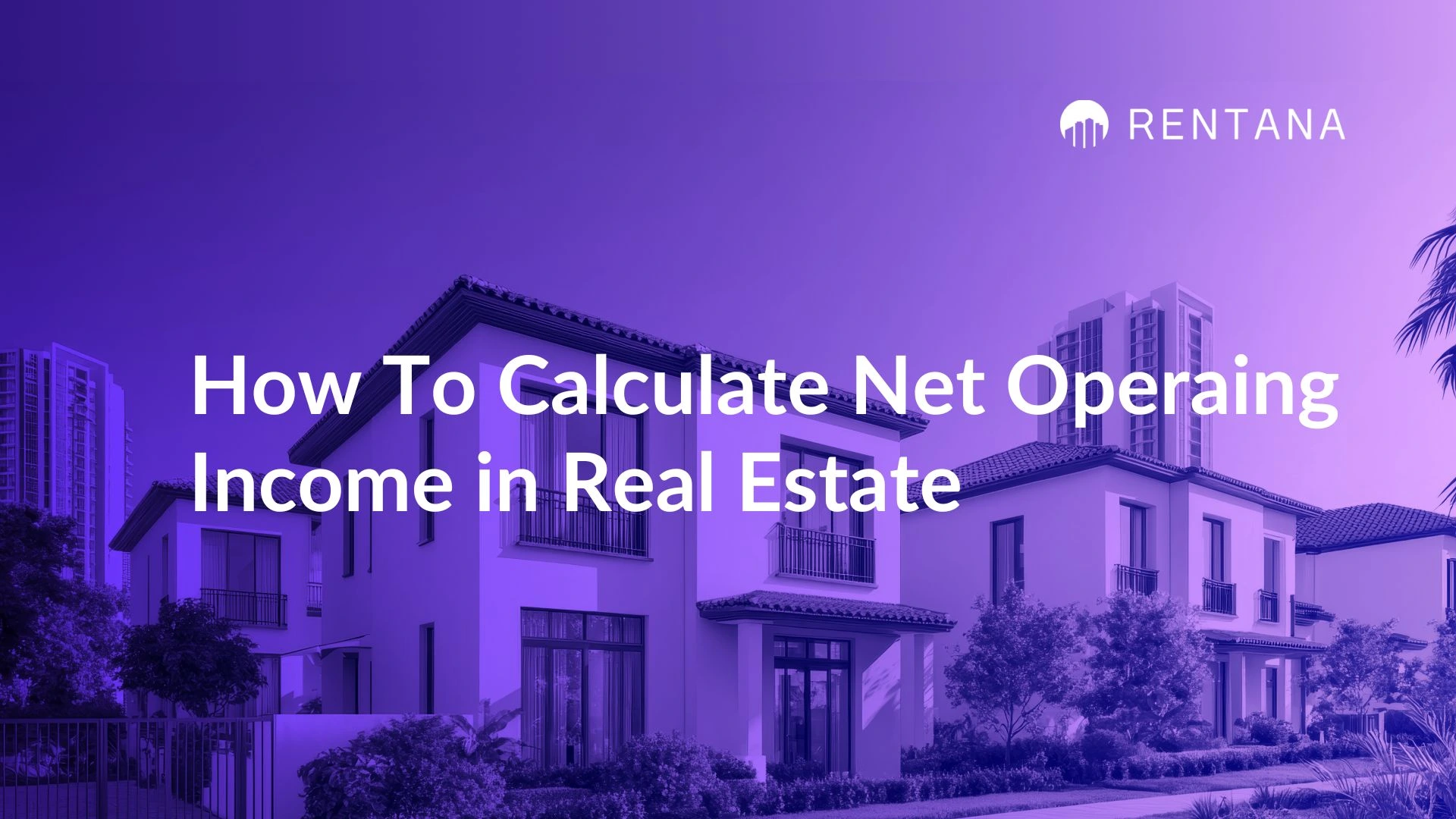




When it comes to multi-family real estate investing, there is one stat that trumps the location mantra; Net Operating Income (NOI).
This metric is the heartbeat of real estate investing because it shows how much money a property is actually making after expenses.
Skipping or miscalculating NOI can be costly. Investors who fail to properly analyze cashflow projections risk missing financial red flags that diminish returns. In fact, lenders and appraisers rely heavily on NOI when deciding a property’s value, which means getting it wrong can set you back from day one.
This article will walk you through net operating income calculation in real estate, what NOI is exactly, why it matters, and how tools like Rentana can make the process faster and more accurate. By the end, you’ll see why mastering NOI goes beyond math, but also about protecting your investments and unlocking long-term growth.
Recommended: How To Do A Rental Market Analysis Like a Pro (With AI Tools)

Net Operating Income, or NOI, is the money a property makes after you subtract the everyday costs of running it. Think of it as the property’s “take-home pay.” It doesn’t include things like mortgage payments or income taxes; just the rent collected minus the operating expenses like maintenance, property management, insurance, and utilities.
Here’s an example: Imagine you own a small 10-unit apartment building. Each tenant pays $1,000 a month, so you bring in $10,000 total. Now, let’s say you spend $3,000 each month on repairs, property management, and other operating costs. That leaves you with $7,000. That $7,000 is your NOI.
Net operating income calculation in real estate is important because it gives a true picture of how profitable a property is. A building with a high NOI is more valuable, while one with a low NOI might be risky. It’s the number lenders, appraisers, and investors look at first when deciding how much a property is worth.

NOI is one of the most important ways to measure how healthy and profitable a property really is. Investors, lenders, and appraisers all use NOI to make decisions, so getting it right can make or break a deal. This makes net operating income calculation in real estate even more important
Property values in real estate often depend on how much income they generate. A higher NOI usually means the property is worth more. For example, two apartment buildings with the same number of units might look identical, but the one with lower expenses and a higher NOI will carry a higher market value. Investors and appraisers look at NOI first when deciding what a building is truly worth.
Banks and lenders use NOI to decide whether they should approve a loan. A strong NOI shows the property can pay for itself while still earning income, which makes lenders more confident. A weak NOI, however, can mean a loan gets denied or comes with stricter terms. For instance, a property with steady rent and low expenses is far more attractive to a lender than one that struggles to cover its costs.
Net operating income calculation in real estate helps investors to know their returns and compare different properties. By looking at NOI, they can see which properties generate the most income relative to their cost. Imagine choosing between a property that makes $50,000 in NOI each year and one that makes $80,000. The second property clearly offers stronger returns and may be the better investment.
NOI isn’t just a one-time calculation. Owners use it to track performance year after year. If NOI is growing, it means the property is becoming more profitable. If it is shrinking, it signals that something needs to be fixed, such as rising expenses or falling rents. Watching NOI closely helps owners catch problems early and make adjustments.
For both investors and managers, net operating income calculation in real estate provides clarity. Instead of relying on gut feeling or surface numbers like rent collected, NOI shows the real bottom line after expenses. It takes the mystery out of whether a property is performing well. With clear NOI numbers, investors can make smarter decisions about buying, selling, or improving a property.
You May Like: Is Multifamily Considered Commercial?

Net operating income calculation in real estate shows how much money a property makes after paying the everyday costs of running it. Follow these steps and you will get a clean, useful number you can trust.
Effective Gross Income (EGI) = GPR + other income − vacancy − concessions − bad debt
These are the costs to keep the property running.
Do not include: Mortgage principal, mortgage interest, income taxes, depreciation, and large one-time capital improvements. Those are not operating expenses.
Now let’s try some real life examples!
Income
Losses
Effective Gross Income (EGI)
Operating expenses
Totals
NOI
Sensitivity mini-check
Operating expenses
NOI after reserves = 31,920 − 11,454 = $20,466
That is the duplex’s yearly operating profit before any loan payments.
Property taxes, insurance, utilities for common areas, repairs, routine maintenance, landscaping, snow removal, pest control, property management, admin, marketing, payroll for onsite staff, supplies.
Loan principal, loan interest, income taxes, depreciation, owner draws, large capital projects like roof replacement or full unit gut renovations. Use replacement reserves to plan for those
Related: Top 9 Real Estate Market Analysis Tools of 2025
Even though the formula for net operating income calculation in real estate is straightforward, many investors make mistakes that lead to misleading numbers. Getting NOI wrong can mean overpaying for a property, missing red flags, or making poor financing decisions. Here are some of the most common errors to avoid:
Mortgage principal and interest are not part of NOI. NOI is meant to show how the property performs before debt service. If you include loan payments, you end up mixing financing decisions with operating performance, which can make two otherwise similar properties look very different.
It is easy to calculate rent as if every unit is always full and tenants always pay on time. In reality, vacancies and missed payments are part of the business. Ignoring them makes NOI look higher than it really is, which inflates property value. Smart investors always apply a realistic vacancy assumption, often around 5% or whatever the local market supports.
Some investors mistakenly leave out expenses like management fees, maintenance reserves, or utilities they pay for tenants. Others accidentally include costs that don’t belong, such as capital expenditures (big projects like a new roof). The key is consistency: only include recurring, operational costs that are necessary to run the property day to day.
Sometimes owners calculate NOI using a single month’s rent roll or last year’s unusually low expenses. That can create a false picture. NOI should be based on a stabilized year’s performance, or adjusted (normalized) to reflect ongoing conditions.
A property might look strong today, but if local taxes are about to rise or new competition is coming, the NOI could shrink. Ignoring future risks means making decisions on outdated numbers. Good investors check both current NOI and projected NOI under different scenarios.
Recommended: 7 Best Asset Management Reporting Software for Multifamily

Calculating NOI used to mean juggling spreadsheets, receipts, and guesswork. Today, technology makes it much easier to track income, expenses, and market trends with accuracy. The right tools can save time, reduce mistakes, and give investors a clearer view of how their properties are performing.
This is why you need Rentana. Rentana is built specifically for real estate owners, multifamily investors, and property managers who want reliable revenue intelligence. Instead of chasing down data from different systems, Rentana brings everything into one platform and gives clear insights backed by AI.
For example, if falling rates are eating into NOI, Rentana highlights the impact so managers can act quickly, whether that means adjusting rents, budgeting differently, or finding efficiency upgrades. By turning raw data into actionable insights, Rentana makes NOI less about guesswork and more about strategy.
Top Pick: The Best AI Tool for Rental Market Analysis by Zip Code
Net operating income calculation in real estate is highly important
If profit is the story of a property, NOI is the plot line that holds it together. It reveals the truth behind the numbers, showing whether a building is really working for you or against you. With careful calculations and tools like Rentana, investors can move from guesswork to confidence, turning NOI into the foundation for smarter, long-term real estate success.
To calculate Net Operating Income (NOI) for real estate, subtract all operating expenses from the property’s gross rental income. Operating expenses include maintenance, property management, insurance, utilities (if paid by the owner), and property taxes, but exclude mortgage payments and capital expenditures.
Formula:
NOI = Gross Rental Income – Operating Expenses
The formula for net operating income (NOI) is:
NOI = Gross Operating Income – Operating Expenses
This shows how much income a property generates after expenses but before financing costs and taxes.
In housing, NOI stands for Net Operating Income. It represents the income a rental property produces after deducting operating costs. It is a key measure of profitability and helps investors evaluate rental properties and determine their potential return.
NOI is directly tied to property value through the capitalization rate (cap rate). Investors often calculate value using the formula:
Property Value = NOI ÷ Cap Rate
A higher NOI increases property value, while a lower NOI reduces it, assuming the cap rate stays the same.
The 7% rule in real estate suggests that a rental property should deliver at least a 7% annual return on investment after expenses. Investors use it as a benchmark to quickly assess if a property is likely to provide strong returns.
A good NOI depends on the market, property type, and investment strategy. Generally, a strong NOI is one that covers all expenses comfortably, produces positive cash flow, and results in a healthy cap rate. Many investors aim for an NOI that supports a cap rate between 6% and 8% in stable markets.